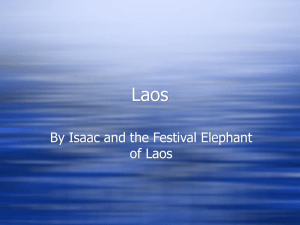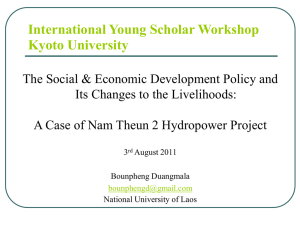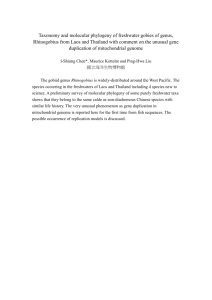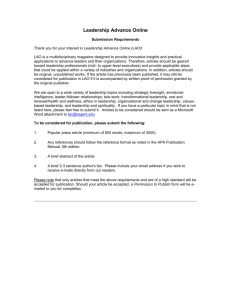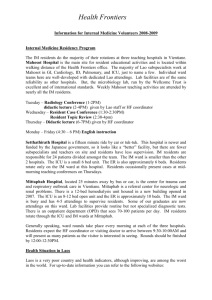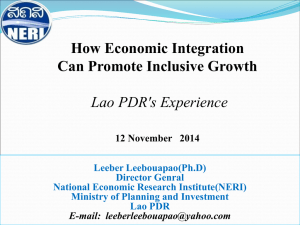Lao PDR – Fact Sheet - The Ministry of External Affairs
advertisement
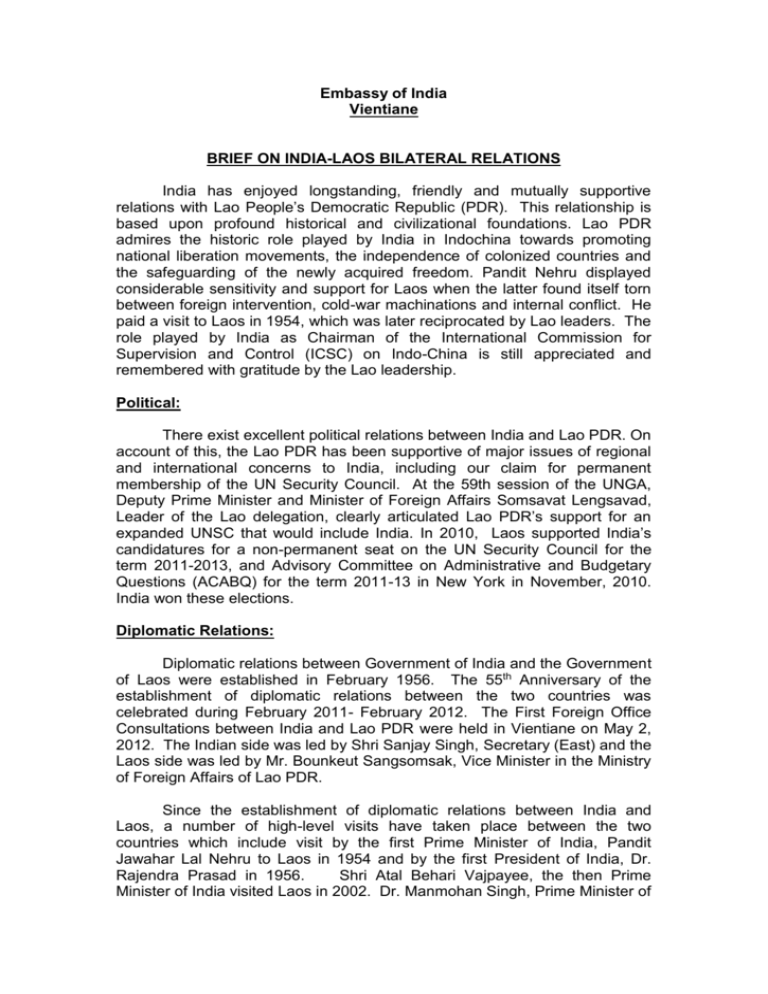
Embassy of India Vientiane BRIEF ON INDIA-LAOS BILATERAL RELATIONS India has enjoyed longstanding, friendly and mutually supportive relations with Lao People’s Democratic Republic (PDR). This relationship is based upon profound historical and civilizational foundations. Lao PDR admires the historic role played by India in Indochina towards promoting national liberation movements, the independence of colonized countries and the safeguarding of the newly acquired freedom. Pandit Nehru displayed considerable sensitivity and support for Laos when the latter found itself torn between foreign intervention, cold-war machinations and internal conflict. He paid a visit to Laos in 1954, which was later reciprocated by Lao leaders. The role played by India as Chairman of the International Commission for Supervision and Control (ICSC) on Indo-China is still appreciated and remembered with gratitude by the Lao leadership. Political: There exist excellent political relations between India and Lao PDR. On account of this, the Lao PDR has been supportive of major issues of regional and international concerns to India, including our claim for permanent membership of the UN Security Council. At the 59th session of the UNGA, Deputy Prime Minister and Minister of Foreign Affairs Somsavat Lengsavad, Leader of the Lao delegation, clearly articulated Lao PDR’s support for an expanded UNSC that would include India. In 2010, Laos supported India’s candidatures for a non-permanent seat on the UN Security Council for the term 2011-2013, and Advisory Committee on Administrative and Budgetary Questions (ACABQ) for the term 2011-13 in New York in November, 2010. India won these elections. Diplomatic Relations: Diplomatic relations between Government of India and the Government of Laos were established in February 1956. The 55th Anniversary of the establishment of diplomatic relations between the two countries was celebrated during February 2011- February 2012. The First Foreign Office Consultations between India and Lao PDR were held in Vientiane on May 2, 2012. The Indian side was led by Shri Sanjay Singh, Secretary (East) and the Laos side was led by Mr. Bounkeut Sangsomsak, Vice Minister in the Ministry of Foreign Affairs of Lao PDR. Since the establishment of diplomatic relations between India and Laos, a number of high-level visits have taken place between the two countries which include visit by the first Prime Minister of India, Pandit Jawahar Lal Nehru to Laos in 1954 and by the first President of India, Dr. Rajendra Prasad in 1956. Shri Atal Behari Vajpayee, the then Prime Minister of India visited Laos in 2002. Dr. Manmohan Singh, Prime Minister of India visited Laos in 2004. The President of India, Smt. Pratibha Devisingh Patil paid a State visit to Laos in September 2010. Minister of Parliamentary Affairs and Water Resources Shri Pawan Kumar Bansal visited Laos in June, 2010. Shri Neiphu Rio, Chief Minister of Nagaland visited Laos in September 2010. Gen. V.K. Singh, Chief of Army Staff of India visited Laos in December 2011. Shri Salman Khurshid, External Affairs Minister of India visited Laos from November 4-7, 2012 to participate in the ASEM-9 Summit. Separately, he held bilateral meetings with H.E. Dr. Thongloun Sisoulith, Deputy Prime Minister and Foreign Minister as well as H.E. Mr. Thongsing Thammavong, Prime Minister of Lao PDR. Dr. K. Chiranjeevi, Minister of State for Tourism visited Laos to attend the ASEAN-India Tourism Ministers’ Meeting held in Vientiane on January 21, 2013. Prince Souphanouvong, commonly known as the Red Prince visited India in 1975. In recent times, the President of the Lao PDR H.E. Mr. Choummaly Sayasone visited India in August 2008. A 15-member delegation led by the Deputy Prime and Minister of Foreign Affairs, H.E. Dr.Thongloun Sisoulith, participated in the 6th India-Lao Joint Commission Meeting held in Delhi during January 2010. Dr. Thongloun visited India once again in 2010. Minister of Finance H.E. Mr. Somdy Douangdy visited India for the India – LDCs Ministerial Meeting on “Harnessing the Positive Contribution of SouthSouth Cooperation for Development of Least Developed Countries” in New Delhi in February 2011. Minister of Industry and Commerce H.E. Dr. Nam Viyaketh visited India for the India-ASEAN Fair and Business Conclave in March 2011. Assistant Minister of Foreign Affairs, Mr. Alounkeo Kittikhoun visited India in March 2011. H.E. Dr. Thongloun Sisoulith, Deputy Prime Minister and Foreign Minister visited India to attend the Mekong-Ganga Cooperation Ministerial Meeting in New Delhi on September 4, 2012. H.E. Dr. Ankhom Tounalom, Deputy Minister, Ministry of Natural Resources and Environment. participated in the ASEAN-India Environment Ministers’ Meeting in New Delhi on September 6-7, 2012. H.E. Mr. Viraphonh Viravong, Vice Minister for Energy and Mines attended the International Seminar on Energy Access held at New Delhi during October 9-10, 2012. H.E. Mr. Vilayvanh Phomkhe, Minister of Agriculture and Forestry led a 6-member delegation to attend the ASEAN-India Agriculture Ministers’ Meeting on October 17, 2012 in New Delhi. H.E. Dr. Nam Viyaketh, Minister of Industry and Commerce attended the 2nd ASEAIndia Business Forum held in New Delhi on December 18-19, 2013. H.E. Mr. Thongsing Thammavong attended the ASEAN-India Commemorative Summit held in New Delhi on December 20-21, 2013. Economic and Commercial: Agreements: Lao PDR and India have signed several agreements over the past few years. These agreements lay down the essential framework for bilateral cooperation in matters relating to science, technology, economic cooperation and trade, as well as in defence and consular matters. Some recent agreements include: (i) A Cultural Exchange Programme for the years 2011-13 was signed in 2010. (ii) An MOU was signed with the Ministry of Information and Culture in May 2007 for the restoration of the world heritage site at Vat Phu. The work on the project began in June 2009. India will spend US$ 4.1 million (Rs. 18.49 crores) on the project over an eight year period. (iii) Since 1994, under the Indian Technical and Economic Cooperation (ITEC) Agreement, an Indian Army Training Team conducts training for Lao defence personnel in English, Computers and Basic Tactics. The Indian team is the only foreign training team besides the Vietnamese and the Chinese. (iv) An MoU on Agriculture Cooperation was signed in 2000. Under the MoU, a Biennial Working Plan is prepared for implementation. Projects under Lines of Credit: A number of projects have been supported through Indian Lines of Credit over the past few years. Some of the recent projects include: (i) In June 2004, India provided a Line of Credit of US$ 10 million for a 115 KV Transmission Line from Ban-Na in Champassak to Attapeu. The project was completed in 2006. (ii) In August 2008, during the visit of President Choummaly Sayasone, an agreement was signed to provide a US $ 33 million loan for 3 projects. WAPCOS is the project management consultant for these projects and Angelique International is the implementing agency. The three projects are: (a) Supply of equipment for rural electrification worth US $ 4 million. This was completed in September 2009. (b) The Paksong-Jiangxai-Bangyo transmission line project worth US $ 18 million. The project was commissioned on September 10, 2010 by the two Presidents. (c) The Nam Song 7.5 MW hydropower project worth US $ 11 million. The project completed in October/November, 2012 and inaugurated in February, 2013. (iii) A US $ 17.34 million loan agreed upon for the development of irrigation schemes in Champasak province, the agreement for which was signed in May 2009. WAPCOS is developing the project. US $ 440,000 has been disbursed. A contract worth US $ 4.3 million has been awarded to Kirloskar Brothers. Letter of award for the US $ 10.1 million project on development of six irrigation schemes in Champasak province to M/s Angelique International Limited by the Department of Irrigation, Ministry of Agriculture and Forestry on March 24, 2011.The third component worth US $ 1.03 million is in the bidding stage. (iv) On September 13, 2010, a loan agreement between Exim Bank and the Ministry of Finance was signed in Vientiane in the presence of the two Presidents for a US $ 72.55 million loan for the following two projects: (i) 230 KV Double Circuit Transmission Line from Nabong to Thabok and sub stations worth US $ 34.68 million; and (ii) 15 MW Nam Boun 2 Hydropower Project worth US $ 37.86 million. Foreign Direct Investment (FDI): India ranked 8th in FDI in Laos with total 33 projects and investments of US$ 161 million. Some Major Indian investments include: (i) Birla Lao Pulp and Plantation, established in June 2006, is committed to investing US $ 400 million in a Eucalyptus pulp and plantation project in Savannakhet province. This is the biggest Indian FDI in Laos. 13619 hectares have been planted in Savannakhet and Champasak provinces till Feb 2012. The company has spent US $ 31 million up to March 2012. (ii) The Lao SPG CMC Mining Company Limited, a subsidiary of GIMPEX India, obtained a license for an iron ore mine in 2008, with a commitment to invest US $ 10 million, out of which US $ 7.7 million has been spent. This is a 200 hectare iron-ore mine at Ta En village, Viengxay district, Samneua province. As of March 21, 2011, the mine has produced 60,717 metric tonnes of iron-ore, of which 56,408 metric tonnes have been exported to China. (iii) The HSMM Group has invested US $ 13.8 million in agarwood plantations and two factories in Vientiane and Xaysomboun, Vientiane province. It has a US $ 800,000 iron ore mine in Sekong province in partnership with Mineral Enterprises Limited, and a US $ 100,000 iron ore mine in Khammuan province. Human Resource Development: Under human resource development, the Government of India has been providing over 210 scholarships to Lao nationals through the Indian Technical and Economic Cooperation [150 slots], the TCS Colombo Plan [40 slots], the Mekong-Ganga Cooperation Scholarship Scheme [12 slots] and the General Cultural Scholarship Scheme [8 slots for higher studies]. under ITEC, GOI has trained about 1000 Lao nationals. So far, The LIEDC (Lao-India Entrepreneurship Development Centre) was set up under India-ASEAN Fund and inaugurated by our EAM in Vientiane on 27 November, 2004, LIEDC trains Lao entrepreneurs for setting up small and medium scale business. The Centre is functioning very well and contributing to development of local entrepreneurship. The LICELT [Lao India Centre for English Language Training] was set up in Vientiane on June 12, 2007 under the India-ASEAN Cooperation framework. The LICELT is one of our assistance projects in human resource development. The effort is in the direction of capacity-building and selfsustaining capability of Laos. India set up an IT centre in Vientiane in November 2004, as well as a National Data Centre in May 2006. Ten Rural Telecommunication Centres were set up, seven in provinces and three in the Ministry of Health, the Prime Minister’s Office and the office of the Governor of Vientiane. Bilateral Trade: India’s bilateral trade with Laos was US$ 9.52 million in 2008-09 with exports at US$ 9.00 million and imports at US$0.52 million. There was dramatic escalation in trade to $37 million in 2009-10. The trade balance which had been overwhelmingly in favour of India turned towards Lao. This development stems primarily from India’s purchase of copper ores and concentrates of $19.7 million from Lao. India’s exports have increased on account of surge in sales of electrical and electronic equipment and pharma products to Lao. However, during 2010-11, the exports were reduced to US$ 14.06 million while imports were practically non-existent at US$ 0.22 million. In 2011-12 the total bilateral trade was US$ 104.50 with exports from India were US$ 14.97 million, while imports from Laos were US$ 89.53. India’s Trade with Lao PDR (in US$ million) S.No. \Year 20072008 20082009 20092010 20102011 20112012 1. EXPORT 3.86 9.00 16.93 13.11 14.97 6. IMPORT 0.11 0.53 20.05 0.22 89.53 11. TOTAL TRADE 3.97 9.52 36.98 13.33 104.50 16. TRADE BALANCE 3.74 8.47 (-) 3.12 Source: Department of Commerce, Government of India. 12.89 (-) 74.56 The Top five exports to Laos include electrical and electronic equipment, articles of iron and steel, aluminium and products, pharmaceuticals and boilers and machinery. In pursuance of the announcement made by the Prime Minister India in April 2008, India has accorded the Duty Free Tariff Preference Scheme (DFTP) to Least Developed Countries. As of September, 2009 Lao PDR was one of 17 countries that sent a Letter of Intent, becoming beneficiary under the scheme. The Scheme grants Laos duty free access to 94% of India’s total tariff lines. On August 13, 2009 India and ASEAN signed the Trade in Goods Agreement. India and ASEAN are negotiating Agreements on Trade in Services and Investment, expected to be concluded shortly. India has intimated all ASEAN members about the completion of its internal requirements for notification of India-ASEAN Trade in Goods Agreement with effect from 1.1.2010. Laos notified the completion of its internal procedures on December 31, 2010. Defence Cooperation: Twenty-five TATA jeeps were gifted to the Lao National Army on January 21, 2003. 20 static line parachutes were presented to the Lao National Army on April 2, 2009. A five-member Indian Army training team led by Captain Dhiraj Kumar conducted a three week training capsule on unexploded ordnance (UXO), mines and improvised explosive devices (IED) from February 22 to March 11, 2011. A three-week Second Intensive Training Capsule on ‘UXOs and Demining’ was conducted during February 12-March 7, 2012, by a fivemember Indian Army team for Lao People’s Army. Indian Diaspora: The 150-strong Indian community has grown in profile, particularly after the formation of the Indian Chamber of Commerce in the Lao PDR in September, 2010. The Indian community is engaged in jewellery trade, the restaurant and hotel industry, manufacturing, garments, mining, plantations and agarwood. A few members work for international organizations, multinationals, consulting organizations and private businesses. Kirloskar Brothers, the Aditya Birla Group, WAPCOS, Angelique International and LaoSPG CMC Mining (P) Limited have offices in Lao PDR. *********** (July, 2013) Embassy of India Vientiane COUNTRY NOTE : LAO PDR Early history of Laos begins with migration of Tai people from South of China into the Siam region and Vietnam comprising modern-day Thailand, Laos and Vietnam. The Theravada branch of Buddhism made its entry early into the region with records indicating civilizational ties with India dating back to 2nd Century B.C. when the then King of Luang Prabang sent emissaries to India to bring relics of Lord Buddha which were then encased in the That Luang Stupa presently located in Vientiane. Luang Prabang and That Luang in that sense represent the pinnacle of friendly ties between the two regions. Yet another symbol of high civilizational significance attached to India is Wat Phou where oldest temple of Shiva dates back to 5 th Century A.D. The Kings from India then constructed the Champa city in the pre-Angkorian period of the 11th century A.D., and the present complex, which is in the ruins, from that period. It predates Angkor Vat. 2. Modern-day Laos has its roots in the ancient Lao kingdom of Lang Xang, established in the 14th Century under King FA NGUM. For three hundred years Lang Xang had influence reaching into present-day Cambodia and Thailand, as well as over all of what is now Laos. After centuries of gradual decline, Laos came under the domination of Siam (Thailand) from the late 18th century until the late 19th century when it became part of French Indochina. The Franco-Siamese Treaty of 1907 defined the current Lao border with Thailand. It got its independence from France on 19 July 1949. In 1975, the Communist Pathet Lao took control of the government ending a sixcentury-old monarchy and instituting a strict socialist regime closely aligned to Vietnam. It celebrates its National Day on 2nd December [1975]. A gradual return to private enterprise and the liberalization of foreign investment laws began in 1986. Its constitution was promulgated on 14th August 1991. Laos became a member of ASEAN in 1997. 3. Political System: According to the present constitution, which was amended in 2003, the Lao People's Revolutionary Party (LPRP) is responsible for setting broad policy guidelines, while the government manages the day-to-day administration. In reality, the two are almost indistinguishable. The National Assembly is subservient to the LPRP. The National Assembly meets twice a year and is elected for a period of five years. The National Assembly's powers have increased since the early 1990s, and its role is now viewed as one of overseeing the government and the judiciary. Government policies are determined by the party through the powerful 11-member Politburo and the 50-member Central Committee. Important government decisions are vetted by the Politburo. The unicameral National Assembly has 132 MPs [LPRP- 128 and non-Party legislators-4] representing 16 provinces and Vientiane capital. Members are elected by popular vote from a list of candidates selected by the Party for a 5 year term. The last National Assembly elections took place in April 2011. 4. Membership of UN and other International organizations: Laos is State Party to a number of UN Conventions on environment, Law of Sea etc. Laos is also a member of many International and UN organizations. It is an important member of ASEAN community. Laos has been accepted as Member of WTO in October 2012. Laos successfully organised ASEM-9 Summit in Vientiane from November 5-6, 2012. The Summit was attended by 11 Heads of State and 21 Prime Ministers, as well as one Deputy Prime Minister, 12 Ministers and the Presidents of the European Commission and the European Council and the Secretary General of ASEAN. Economy: 5. The government of Laos began decentralizing control and encouraging private enterprise in 1986. The results, starting from an extremely low base, were striking - growth averaged 6% per year in 1988-2007 except during the short-lived drop caused by the Asian financial crisis beginning in 1997. Laos is a landlocked LDC with underdeveloped economy particularly in the rural agricultural areas. 6. The economy of Laos is essentially a free market system with active central planning by the government. Laos has negligible industrial capacity, an undeveloped and underproductive system of agriculture, and increasingly relies on its rich natural resources to earn much needed foreign reserves. In particular, the hydropower, mining, precious metals, and timber sectors have attracted major investment from Thailand, Vietnam, and in the last decade, China. Vietnam is now the largest source of foreign direct investment (FDI) in Laos. 7. The government relies heavily on foreign assistance for public investment, and despite escalating revenues from the natural resources sector, shows no signs of significantly reversing this trend. The seventh 5year plan (2011-15) calls for a budget of U.S. $5 billion for public investment, U.S. $3.8 billion (76%) of which would come from foreign assistance. Tourism remains a bright spot of the Lao economy, offering real future potential, solid growth, and substantial job creation. Laos has begun the World Trade Organization accession process, with the intention of joining the organization as soon as possible. International indices rate Laos poorly on transparency and ease of doing business. Trade Figures: Exports of goods fob: US$ 1.60 billion (2012) Exports - commodities: Copper, gold, timber, garments, electricity, and coffee, cassava Exports – main destinations (2010): Thailand 33%, China 23.4%, Vietnam 13.4%. Other major countries of exports are UK, US, France, and Germany. Imports of goods cif : US$ 2.72 billion (2012) Imports - commodities: Capital goods, machinery and equipment, vehicles, fuel, consumer goods Imports – main origins (2010): Thailand 65.2%, China 11.1%, Vietnam 6.5%. Other major countries of imports are South Korea, Japan, Singapore and Germany Foreign Exchange Reserves excl gold: US$ 699 million (March 2013) GDP : US$ 9.269 billion (2012 est.) GDP Per Capita US$ 1505 (2012-13) Real GDP growth : 8.3% (2012 est) Debt - external: US$ 5.599 billion (31 December 2010 est.) Agriculture: 8. Agriculture is mostly subsistence rice farming, dominates the economy, employing an estimated 75% of the population and producing 33% of GDP. Laos relies heavily on foreign assistance and concessional loans as investment sources for economic development. In 2010, donor-funded programs accounted for approximately 8.5% of GDP and 90% of the government’s capital budget. Hydropower potential: 9. The water resources of the Mekong River and its tributaries are estimated to hold a hydropower potential of 23,000 MW in Lao PDR. Of this, about 15,000 MW are internal to the country, and the remaining 8,000 MW represent the country’s share in the mainstream Mekong, jointly with one or more riparian countries. At present, Laos has 17 operational power plants with installed power production capacity of about 2,560 MW. In addition, about 70 power plants are now in the planning and feasibility stages. In the first six months of the fiscal year (1st October 2010 – 30th September 2011), Laos exported 64% of the electricity generated to Thailand and Vietnam which was of the value of US$ 340 million. Despite the increase in output, Laos imported about 735 million KWH from Thailand, Vietnam and China to secure electricity for border areas not accessed by the national power grid. Laos hopes to end electricity imports in 2015. At present, about 78% of households have access to electricity. The government plans to ensure 90% of house holds have access to electricity by 2020. Natural resources and the environment: 10. Laos is a mountainous, landlocked country, bordered by China to the north, Vietnam to the east, Cambodia to the south, Thailand to the west and Myanmar to the north-west. Southern Laos is less hilly but still rugged. Forests covered 17m ha, or 70% of Laos's land area, in the 1940s, a figure that has now dropped to about 40%, largely owing to serious deforestation. Of the many rivers, the most important is the Mekong, which constitutes a natural border with Thailand and Myanmar. 11. The most valuable natural resources of Laos are its forests and rivers. However, there are concerns about the sustainability of the exploitation of the forests, and not just because of the logging industry; hydroelectric facilities, commercial plantations and slash-and-burn agriculture are also contributing to deforestation. Laos is endowed with a wide range of mineral deposits, the most important of which are tin, lead, gravel, gypsum and salt, although there are also small deposits of coal, iron ore, gold, and oil and gas. Surveys to determine the extent of natural resource deposits are incomplete. Demography: 12. With a population of 6.44 million, Laos is considerably smaller than that of its neighbours, and this limits its attractiveness as a consumer market. Around 27% of the population lives in urban areas, which is a growing proportion but one which still reflects an overwhelmingly rural society. The country is sparsely populated. The south is much poorer than the central and northern parts of Laos. The main ethnic groups consist of Lao Loum (lowlanders) 68%, Lao Theung (lower mountain dwellers) 22% and Lao Soung (highlanders) 9%, ethnic Vietnamese/Chinese 1%. Education: 13. The poor quality of the education system is one of the major constraints to development prospects. Although the situation is improving, only 68.7% of the adult population is literate, according to the UNDP. Laos suffers from a shortage of schools, a lack of textbooks, poorly qualified teachers and low school enrolment and completion levels, especially among girls. Net enrolment rates are rising very slowly, reaching 94% in primary level but only 40% at secondary level. Health: 14. Health standards in Laos are low compared with countries in the region. Underlying these poor standards is a public health system that has been inadequately maintained and that is inaccessible to a large percentage of the population. According to the UNDP's Human Development Report, public healthcare expenditure stood at only 0.8% of GDP, with the number of people seeking private healthcare steadily increasing. The government is focusing on the development of a more efficient primary healthcare system and in recent years has managed to reverse the trend of falling immunisation rates. Much of the funding for these initiatives comes from international donors. Water and sanitation are a serious problem throughout the country. Transnational Issues: 15. Talks continue on completion of demarcation with Thailand but disputes remain over islands in the Mekong River. There are concerns among Mekong Commission members including Laos that China's construction of dams on the Mekong River is impacting navigation along the key Southeast Asian artery and destroying fishing resources. Unexploded Ordnance (UXO): 16. Lao PDR is the world’s most heavily bombed country per capita. Twothirds of the country, mainly in the uplands, is still contaminated with the unexploded ordnance from the Indo-China war. Besides killing or injuring about 300 people each year, it prevents the use of land for agriculture and animal husbandry. It also adversely impacts development and poverty reduction. A number of international donors are helping Laos in clearing the UXOs. (July, 2013) ******************** Embassy of India Vientiane Lao PDR – Fact Sheet Official name Lao People's Democratic Republic Form of Government Parliamentary form The executive The Council of Ministers is the highest executive body and all members of the council are appointed by the chairman of the Council of Ministers (the Prime Minister) Head of State President, H.E. Mr. Choummaly Sayasone Head of Government Prime Minister – H.E. Mr. Thongsing Thammavong National legislature A unicameral National Assembly; Present number of MPs: 132 [LPRP- 128, Non-partylegislators-4] representing 16 provinces and Vientiane capital. Members are elected by popular vote from a list of candidates selected by the Party for a 5 year term. National elections The last National Assembly election took place in April 2011. Political Parties Single party i.e. The Lao People's Revolutionary Party (LPRP) dominates the government and bureaucracy. Government policies are determined by the LPRP through the powerful 11-member Politburo and the 50-member Central Committee. Important government decisions are vetted by the Politburo. Area It has a total area of 236,800 sq km, of which land is 230,800 sq km and water 6,000 sq km. Population 6.44m (2010, IMF) Currency Kip (K), 1US$ = 7700 Kip approx. (in June, 2013) GDP US$ 9.269 billion (2012 est.) Real GDP growth rate 8.3% (2012 est) GNI Per Capita US$ 1505 (2012-13) Total Trade Exports: USD 1.60 billion (2012) Imports: USD 2.72 billion (2012) Forex Reserves USD 699 million (March 2013) Main resources Agricultural products, copper, tin, gold, iron ore, coal, gypsum, cement, timber, hydro-power, tourism, etc. Language Lao (official), English, French, and various ethnic languages Boundary Land boundary is 5,083 km of which with Myanmar it has 235 km, Cambodia 541 km, China 423 km, Thailand 1,754 km, Vietnam 2,130 km. (July, 2013) ******
